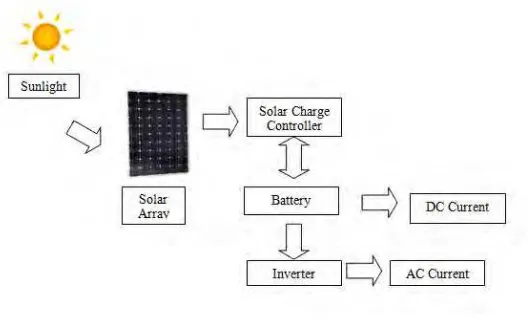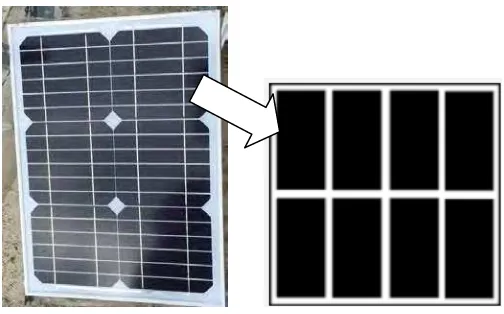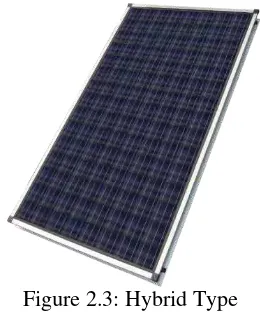UNIVERSITI TEKNIKAL MALAYSIA MELAKA
DESIGN OPTIMIZATION OF 250WP STAND ALONE PORTABLE
SOLAR PV FOR REMOTE AREA APPLICATION
This report submitted in accordance with requirement of the Universiti Teknikal Malaysia Melaka (UTeM) for the Bachelor’s Degree in Electrical Engineering
Technology(Power Industrial)
by
NOR SUHAIDAH BINTI SAPIEI
B071210181
901205016240
vi ABSTRACT
Rural electrification is vital especially to farfetched electricity such as mountain, and island. Since long ago, the electricity source look forward by those a needy such as aborigine. This paper focus on the aborigine community in Kampung Sungai Lah, Tapah, Perak which have 40 villages that lack of the electricity. The project is aimed to design the 250WP stand-alone portable solar PV that can be used for rural communities and to identify the capacity of battery and sizing for design the product. The stand-alone system and PV module (Mono-crystalline) is being used. To design this product, software AutoCAD has been used.
vii ABSTRAK
Bekalan elektrik luarbandar adalah penting terutama kepada kawasan pedalaman seperti di bukit, hutan, pantai. Sejak dahulu lagi, sumber elektri sangat diharapkan oleh orang-orang yang memerlukan seperti orang asli. Fokus utama kertas kerjainikepadamasyarakat Orang Asli di Kampung Sungai Lah, Tapah, Perak yang mempunyai 40 kampung kekurangan bekalan tenaga elektrik. Projek ini bertujuan untuk merekabentuk 250wp “Stand Alone PV Solar” yang boleh digunakan untuk masyarakat luar Bandar dan untuk mengenalpasti keupayaan bateri. Projek ini menggunakan sistem “stand–alone” dan PV modul (Monokristal). Untuk mereka bentuk produk ini, perisian AutoCAD telah digunakan. Sistem ini pada dasarnya terdiri daripada panel solar 250WP Mono kristal yang bersambung secara langsung dengan 2 bateri asid plumbum dalam kitaran 12 volt dengan kapasiti 67Ah untuk setiap melalui caj pengawal solar dan penyongsang 200W.
viii
DEDICATIONS
To my beloved parents FATHER
Sapiei Bin Hj Kasah MOTHER
Hamidah Binti Abd Hamid My sibling and friends
Thank you for the patients, support and encouragement due to completed my report.
viv
ACKNOWLEDGEMENT
I am grateful and would like to express my sincere gratitude to my supervisor Mrs. Emy ZairahBt Ahmad and co-supervisor Mrs. Amalia Aida Binti Abd Halim for her invaluable guidance, continuous encouragement and consistence support in making this research possible. I really appreciate her guidance from the initial to the final level that enabled me to develop an understanding of this research thoroughly.
I am extremely thankful to my panel Mr Engr Asri Bin Din and Mrs. Nurul Ashikin Binti Mohd Rais and all faculty members for their coordination and cooperation and for kind guidance and encouragement.
vv
2.1 Type of Photovoltaic (PV) Modules 6
2.1.1 Polycrystalline 6
2.1.2 Monocrystalline 7
2.1.3 Hybrid 8
2.1.4 Thin Film 9
vvi
2.3 Battery 12
2.4 Inverter 13
2.5 Photovoltaic (PV) system 13
2.5.1 On Grid System 14
2.5.2 Stand-Alone Photovoltaic Power System
15 – 16
3 METHODOLOGY
3.0 Flow Chart 17
3.1 Solar Irradiance In Ipoh, Perak 20 3.2 Peak Sun Hour (PSH) On Location 21 3.3 Calculation of sizing equipment 23 3.3.1 Calculation of usage appliances 23
3.3.2 PV array sizing 23
3.3.3 Battery sizing 24
3.4 Stand-alone estimation 25
3.5 Initial design 27
3.6 Flowchart for completion 29
4 RESULT AND ANALYSIS
4.0 Project development 31
4.1 Solar panel 34
4.2 Solar charger controller 35
4.3 Inverter & battery 37
4.4 Analysis project 40
4.4.1 testing with different angle 42
4.4.2 analysis of battery 48
4.5 Cost analysis 50
5 CONCLUSION AND RECOMMENDATION
5.0 Overall conclusion 51
vvii
REFERENCES 56
APPENDICES
APPENDIX A 53
APPENDIX B 54
vviii
LIST OF TABLE
TABLE TITLE PAGE
3.1 Usage Equipment 23
3.2
Result of Difference Discharge CutoffLimit at PV Stand Alone
Estimation 26
3.3
Result of Difference Discharge CutoffLimit at PV Stand Alone
Estimation 27
4.1 Electrical Characteristics for 20WP 34
4.2 Mechanical Parameters 35
4.3 Mode of solar Control charger 37
4.4
The Output of Voltage And Current From Solar Panel With Two
Different Angle At 3.00 PM 41
4.10 Example of Appliance Usage 47
4.11 Cost By Using Two Different Solar Panel 49 4.12 Usage Appliances 250WP Solar Panel 50 4.13
vix
2.5 Solar Charge Controller 10
2.6 Example Of PWM Type At Faculty Of Electrical Engineering (FKE)
11
2.7 Example Of MPTT Type 11
2.8 Connection Of Battery 12
2.9 Example Of Battery 12
2.10 Example Of Inverter At Faculty Of Electrical Engineering (FKE)
13
2.11 Block Diagram On Grid PV System 14
2.12 Direct Couple PV System. 15
vx
2.14 Example Of Stand Alone System At Faculty Of Electrical Engineering (FKE)
16
3.1 Flowchart 18
3.2 Solar Energy and Meteorology in Ipoh, Perak 20 3.3 Graph Of Insolation For One Year. 20 3.4 Graph Average Of Temperature And Wed Day For One Year 21
3.5 Graph Of Peak Sun Hour 22
4.1 O Optimize Design For 20WP Solar Panel 31
4.2 The Arrangement Inverter and Battery 32
4.3 Project With Handling 33
4.4 20WP Solar Panel 34
4.5 Solar Charge Controller 36
4.6 Inverter with 12v, 500w 38
4.7 GP battery with 7.2AH, 12V 39
4.8 Measured value of Voc 40
vxi
4.10 Output at Angle = 150 41
4.11 Solar Energy and Meteorology in Ayer Keroh, Melaka 42 4.12 Graph Voltage Vs Time For Different Angle 46 4.13 Graph Current Vs Time For Different Angle 46
4.14 Indicator of Work Mode 48
vxii
LIST OF APPENDICES
APPENDIX TITLE
A Gantt Chart 53
B Data Sheet Solar Panel 250wp 54
1
CHAPTER 1
INTRODUCTION
This section will cover or describe clearly about the product, the objective that need to achieve, the limitation of this product, the problem statements and solutions to overcome the problem.
1.0 Background of Study
Today there are many types of green energy that is introduced such as biomass, solar, thermal and hydro. According to Alphousseyni et.el,(2014), defines the primary oil resources are becoming increasingly scarce and expensive, while world energy demand is continuously increasing, therefore the constraint is to use economical renewable energies such as electricity generation from wind or solar radiation
The development of a renewable energy sources has attracted a lot of attention from both the research and industrial community since last decades (M.A. Islam et.el,
2
Providing grid electricity in remote areas is often associated with higher costs to the grid supplier (Vincent, 2014). Noridzuan Idris et.al (2010) defines the grid extension to remote and an inaccessible area is not a cost effective option and sometimes technically not practicable, thus a good option is to use Stand Alone Photovoltaic Power System (SAPVPS). According to M.A. Islam et.el, (2014) defines out of many potential renewable energy sources, PV technology clearly distinguished itself from the other because of its popularity.
As the solution, this product would replace the traditional direct power generator. Portability of the system permits usage in rural applications. Therefore, the purpose of this paper is to design optimization of 1kwP stand alone portable solar PV for a remote applications. For the design part, the system need PV module, Inverter, Battery and Solar Control Circuit. The PV module is connected to solar control charger and passes through battery and inverter. From the battery its will connected to the DC load and the inverter to the AC load.
3 1.1 Problem Statements
Energy is the ability to do work, where it done when force moves an object. The energy can’t be touch or see but can see the effect of the energy such as work done. The electrical energy is energy that stored in charged particles within an electric field. Today, electricity is an important resource whereby from a source the electrical home appliances such as fans, lights, televisions and etc can be used or functions.
As we know all of energy sources that come only from Tenaga Nasional Berhad (TNB). From the previous study at Kampung Sungai Lah, Tapah Perak, some problem has been obtained, first there are have 40 villages that lack sources of electricity and some of them for used a generator as a supply. At night, most of the residents are using candles or kerosene lamps as a lighting resource.
This can contribute to negative factors such as can cause of death or fire. Lastly, the resident has a fully equipment such as a distribution board and household equipment but don’t have any supply of electricity.
4 1.2 Scope Project
There are has several objective need to achieved, it has some scope and limitation. As there are many types of solar panel, for this research using PV solar (Mono Crystalline). This paper focuses on the design portable solar with 300 inclination angle that can used for aborigine community at Kampung Sungai Lah, Tapah, Perak on facilitates basic usage such as lighting, fan, and socket).
1.3 Objective
For this paper there are have some objective that need to be achieved and overcome for this problem:
i. To design the 250wp stand-alone portable solar that can be used by this community.
ii. To determine the capacity of battery and sizing the component for these prototype.
5
CHAPTER 2
LITERATURE REVIEW
This chapter briefly expalain about the history renewable energy, the type of solar panel, the components that consist at the stand alone system. This parts also tell the previous study from other author or jurnals about the system.
2.0 Solar Systems
Renewable energy is an energy produced from natural resources such as sunlight, geothermal heat, tides and wind. Renewable energy technologies range from solar power, wind mill, hydroelectricity or micro hydro, biomass, and bio fuels for transportation. Solar is one of the good alternative ways to get the supply for some place that lack of source electricity especially in rural area. Solar panel has four type which; Polycrystalline, Mono Crystalline, Hybrid and Thin Film.
6
The power output from photovoltaic (PV) modules depends on environmental conditions and geographical location (Pooja et.el, 2014). According Pooja et.el, (2014), currently the c-SI (robust) and thin film (flexible) PV cell are the two major technologies in wide use. For this project, Monocrystalline type has been chosen compared to other type depends on advantage reasons itself.
The solar system is classified into two type On Grid system and Off Grid system. According to Mfon et.el (2013), development of a solar energy research programmed, must always start with a study solar radiation data at the site region of interest. For this paper Tapah, Perak is the location that has been chosen
2.1 Type of Photovoltaic (PV) Modules
2.1.1 Polycrystalline
7
Figure 2.1: Polycrystalline Panel
2.1.2 Mono crystalline
Mono crystalline is the first generation solar technology; it has providing evidence of their durability and long life. The solar cells in mono-crystalline panels are slices cut from pure drawn crystalline silicon bars. As PV panel made of single crystal silicon cell manufacturing process they are one of the most complex and expensive. The entire cell is aligned in one direction, which means when the sun is shining brightly on them at the correct angle, they are extremely efficient. This PV panels are able to convert the highest amount of solar energy into electricity of any type of flat solar panel.
8
Figure 2.2: Mono crystalline Type
2.1.3 Hybrid
This module has a thin layer of amorphous solar film behind the mono crystalline cells. The extra amorphous layer will extracts even more energy from the available sunlight, particularly in low light conditions. Hybrid panel is more expensive than mono or poly-crystalline panels; it will affect the energy produced. The hybrid type also can generate a large power from a smaller area. These types is a water-drainage frame where the frames helps to keep modules clean even in low-angle installations and has high efficiency which means module efficiency is 19% and a cell conversion efficiency is about 21.6%.



